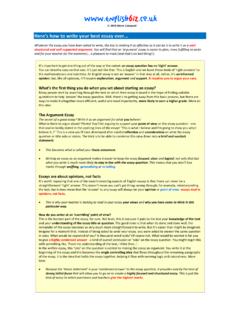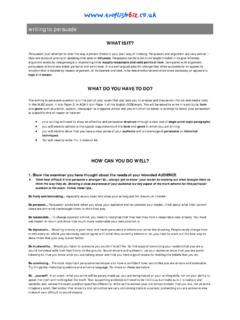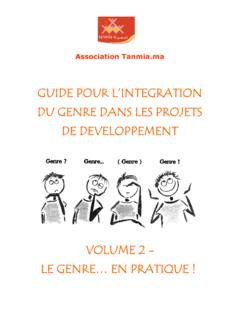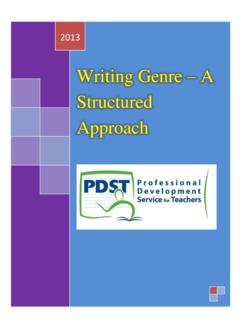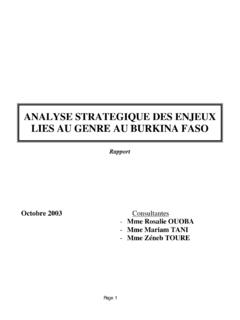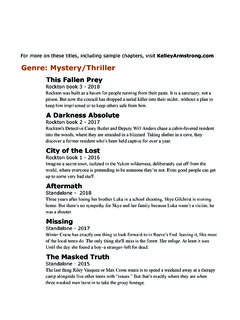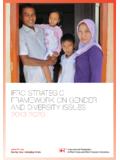Transcription of with each genre borrowing elements and …
1 2008 Steve Campsall Non-Fiction and Media Texts Non-fiction texts are a part of everyday life. They are a genre of writing that is worth studying because such texts can be very influential, for instance by using highly persuasive techniques that are carefully designed to appear like unbiased information. Being able to recognise this rhetoric for what it is and to understand how such a text works on its audience is a genuinely useful life skill. Nonfiction includes biographical and autobiographical writing, travel writing, journalistic writing and reportage such as found in newspapers and magazines, letters, signs, menus, even cereal packets and much, much more. For school exams, you won't be studying cereal packets however! Unlike the imaginary worlds and characters of fiction, non-fiction texts are based on real people, real things and real events.
2 A key understanding is that this doesn't necessarily make them factual or true. While nonfiction is based on the real world and fiction is based on an imagined world, there are important overlaps with each genre borrowing elements and techniques from the other. Fiction often borrows from nonfiction to help create a sense of realism and believability, for example by using real place names in which to set its stories; non-fiction borrows, most especially, the story form called narrative to create absorbing and interesting writing. For example a newspaper story might well separate people, just like a fictional story, into 'heroes' and 'villains' and create suspense and tension to make it more interesting to read. Media texts include writing such as newspaper and magazine articles. Such texts are mostly a subcategory of nonfiction but are treated separately in some exam syllabuses.
3 An important aspect of media texts concerns the audience for which they are written which, because it is always a mass audience, will be composed of individuals completely unknown to the writer. Media texts often include images. Remember that the exam is testing your abilities to analyse and discuss the use and effects of language so avoid prolonged discussion of images. 1. In your exams you will be tested on your ability to analyse and discuss non-fiction or media texts. Usually you will also be asked to compare two different texts that share a similar theme but which have either a different genre or form or which approach their theme from different angles. WHAT DOES THE EXAMINER LOOK FOR? While exam questions vary, the skills you need do not. You will be asked to analyse, consider and discuss a non fiction or media text at four levels: What is the text about - its subject matter You need to show you have understood the text's subject matter and content.
4 You will also need to be able to locate details and discuss aspects of these (this requires an understanding of the text's big picture). Who has the text been written for - its audience This is v-e-r-y important - you need to consider audience with care as it will help you recognise features of style that you can discuss in your answers. Writing about audience means recognising and showing how a text has been created to suit a particular kind of reader. o When a writer is asked to write a text, one of the key questions asked is who the text is aimed at. With knowledge of the text's audience, only then will the writer be able to consider the most suitable style of writing to choose - its content, its vocabulary choices and its tone. How has the text been made to 'work'. - the writer's methods and their effects You need to be able to identify the methods a writer has used to create the text.
5 This includes considering aspects of the text's genre , style, language and structure. You will also need to be able to discuss the effects of these methods on the audience - and, of course, the purpose behind these effects. It most especially means looking closely at the language and layout used in the text. o How is language being used - what effects are being created and for what purpose? o How is the layout helping the text achieve its purpose for its audience? 2. Why was the text written - its writer's purpose This means recognising the messages contained within the text, both on the surface and - although this is not so important compared to literary texts - if there are different layers of meaning. WHAT KIND OF EXAM QUESTIONS MIGHT YOU MEET? There are four typical types of exam question you could come across (note that the examples below are not based on any particular nonfiction texts): Questions that ask you to identify or locate details: 'What types of exercise are discussed in the newspaper article?
6 '. 'Identify five advantages and five disadvantages to exercising regularly mentioned in the newspaper article.'. 'List five facts and five opinions the writer includes in the newspaper article.'. In this type of question, you are being asked to locate specific named details directly from the text and list them. Normally one mark will be awarded for each correct point you make. Unless made obvious within the question, the answer does not need extra explanation or to be written in your own words - a numbered list would make a good answer. Questions that ask you to explain and summarise: 'What impressions does the article create concerning the need for exercise?'. 'How does the writer defend the need for exercise?'. 'What are the writer's attitudes towards exercise?'. In this type of question, you need to write a considered personal response and use evidence from the text to support what you say.
7 This type of question requires a mixture of your own words and quotations from the text. Marks are awarded more for depth of answers than breadth - you need to show an understanding of how language choices work. Questions that ask you to discuss the writer's techniques: 3. 'How does the writer try to persuade the reader that exercise is a good thing?'. 'What impression of fitness does the writer create?'. 'How is the article made convincing?'. In this kind of question, you would need to discuss, for example, the persuasive techniques used by the writer or the way something has been presented in the text. This means considering aspects of language, style and structure to show how these work for a specific audience and purpose. This type of question tests your awareness of how language can be used for a specific audience and purpose.
8 It requires a considered, reflective and insightful response using a mixture of your own words and quotations from the text. Questions that ask you to compare texts 'Which of the two articles do you consider the most persuasive? '. 'Which of the two texts do you find the more interesting and why? '. This type of question needs a close discussion on the two articles. You will need to comment on aspects of audience, purpose, language and style. As before, you are being tested on your awareness of how language can be used effectively for a specific audience and purpose. Again, this type of question expects a considered, reflective and insightful response using your own words with support provided by quotations from the text. WHAT YOU NEED TO DO TO GAIN A HIGH GRADE. As with all texts, non-fiction and media text need the skills of analysis and commentary.
9 In any text, its writer's aim is to create a style that will suit a particular kind of reader or audience to achieve a certain purpose. The style created will utilise the two aspects language has: its form and its content. These two aspects will be working together to create certain effects on the reader, and, in turn (and accumulating through the structure of the text), these effects, the writer hopes, will achieve the text's purpose. 4. The purposes of non-fiction texts are various: to entertain to explain to inform to advise to persuade to instruct .. and very often, are a combination, particularly of information, persuasion and entertainment. HOW TO TACKLE NON-FICTION AND MEDIA TEXTS. It's important that you work out and mentally summarise the big picture of the text. Ask yourself how the text's layout and presentation help it in various ways.
10 O The layout and presentation of a text is a part of its form. Form refers to the way a text looks (or sounds). o In many non-fiction texts, layout and presentation are always carefully chosen to aid the audience in following and understanding the text. Work out how the text's structure allows its detail and information to unfold - and often persuasive - in useful ways. How are facts being used? Are they presented in a way that is biased? Or is the information balanced? Are facts being chosen selectively? How are opinions presented? In persuasion, opinions are never balanced and are given a sense of authority and influence. Work out how this is being done. Look closely to see if the text sets out to create an emotional response, though the use of emotive language. For the highest grades, see if you can work out if the text's genre conventions create some kind of important response in the audience.





